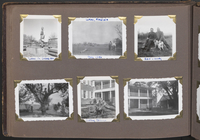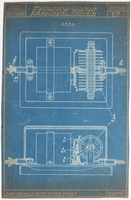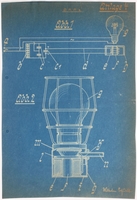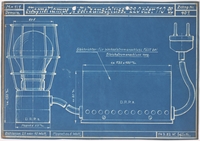Overview
- Credit Line
- United States Holocaust Memorial Museum Collection, Gift of Jackie Gish
Physical Details
- Language
- German
- Classification
-
Information Forms
- Category
-
Reproductions
- Object Type
-
Blueprints (lcsh)
- Physical Description
- Rectangular piece of paper. The front is blue, the reverse is nuetral off-white. The from has white lettering and the diagram is in white. The blue print is of a patenent application diagram. Across the top reads "M.=1.1/110÷125 Volt" "Gleichrichter montiert." "Zchng.Nr./417." There are two diagrams, one aerial view on top and then a side view below. Along the bottom reads "Schalt-Schema: tT. Paten-Zeichng. Anlage 4. 14.2.33 Enf." T
- Materials
- overall : paper
Rights & Restrictions
- Conditions on Access
- No restrictions on access
- Conditions on Use
- Restrictions on use. Copyright on material created by members of the extended family are either out of copyright or copyright is undetermined.
Administrative Notes
- Legal Status
- Permanent Collection
- Provenance
- The blueprint was donated to the United States Holocaust Memorial Museum in 2014 and 2016 by Jackie Gish.
- Record last modified:
- 2022-07-28 18:30:21
- This page:
- https://collections.ushmm.org/search/catalog/irn538724
Download & Licensing
In-Person Research
- By Appointment
- Request 21 Days in Advance of Visit
- Plan a Research Visit
- Request to See This Object
Contact Us
Also in Metz and Oberlaender families collection

Metz and Oberlaender families papers
Document
The Metz and Oberlaender families papers consist of documents, correspondence, photographs, biographical materials, and immigration materials related to the Metz family, originally of Frankfurt am Main, Germany and to the Oberlaender family, originally of Fürth and Frankfurt am Main, Germany. Gabrielle Metz and Hardy Oberlaender met in Frankfurt, were married in Chicago, and were eventually joined by many of their family members in the United States. The papers of both families are especially valuable to researchers because both sides of the correspondence are represented: the first family members to immigrate to the United States and the family members who remained in Europe and came to the United States later. The Metz family papers consist of photograph albums, biographical materials and correspondence related to Gabrielle Metz, additional correspondence among the Metz family and their friends, letters Gabrielle received from her parents and brother, and printouts of digitized records of family tree information, correspondence and photographs that remain with the family. The papers document Gabrielle Metz’s prewar life in Germany, her immigration to the United States in 1939, her efforts to remain in contact with her family, her mother’s death, her father’s immigration in 1946 and her brother’s immigration in 1947. The photograph albums largely date from before the war and document Gabrielle’s school years and the Metz family’s life in Frankfurt in the 1920s and early 1930s. The postcard album includes postcards mostly mailed to Gabrielle Metz by friends and relatives between 1912 and 1932 celebrating birthdays and holidays or describing travel. The postcards include commercial artistic and photographic images and are accompanied by a handful of photographs of friends. The documents related to Gabrielle Metz Oberlaender include her emigration and naturalization documents and menus from the SS Veendam, August 27, 1939-September 4, 1939. This series also includes original typed copies of Gabrielle’s correspondence to her parents and brother from 1939-1942, and more than one hundred telegrams and condolence letters she received after her mother’s death in December 1941. The series further contains documents and forms attesting to Gabrielle’s efforts on behalf of her family, including her notes after appearing before an Interdepartmental Visa Review Committee in Washington, DC, in 1944. The general correspondence series includes correspondence exchanged among the Metz family and extended family or friends. This subseries includes letters from Fritz Trier, Hansi Metz’s cousin, who survived in Mexico, and Leo Trier, her nephew, who survived the war in France; a few letters from Selma Metz, Gottfried’s sister, who committed suicide to avoid deportation in October 1940 in Frankfurt; and letters written by Henny Kahn, Gabrielle’s cousin, who escaped to Brazil, and her partner, Anna, who remained in Germany. The letters from Gottfried, Hansi, and René Metz to Gabrielle are extensive. With the exception of late 1942-1945, when the war restricted mail services, the family corresponded on a weekly basis, if not more frequently, in lengthy handwritten letters. Printouts consist of printed copies of digitized original materials that remain with the donor’s family and include family tree information, photographs, correspondence, and family documents. They document the Metz, Trier, and Gutenstein families, and the family tree information explains the relationship between the subject of each folder and the Metz family. This subseries documents not just the Metz family in Europe and the United States but also Fritz Trier, who immigrated to Mexico, Leo Trier, who survived in France, and Willy Schlesinger and his daughter Gerda, who immigrated to Argentina. The Oberlaender family papers include biographical materials, correspondence, immigration materials, and digitized records documenting the Oberlaender family from Fürth and Frankfurt. The papers document Hardy Oberlaender’s immigration to the United States in 1934, his brother Fred’s immigration and his father’s death in 1937, his brother Ernst and his mother’s arrival in the United States in 1938, and the family’s efforts to keep in touch with relatives who remained in Europe. Biographical materials include an address book, driver’s license, employment records, and a police clearance certificate documenting Joseph, Felicia, Hardy, and Leopold Oberlaender; death announcements and funeral speeches for Joseph Oberlaender and Nelly Wittman (Lilly Oberlaender’s mother); and narratives documenting Hardy’s cousin Alfred Davidsohn’s arrest and deportation. Correspondence primarily consists of Hardy Oberlaender’s correspondence with his parents and brothers as they each lived in Frankfurt, Brussels, London, Amsterdam, and Chicago. This subseries also contains correspondence with relatives Leopold and Lilly Oberlaender, Eleanor Fuchs, Betty and Alfred Abraham, Alfred Davidsohn, Sophie and Felix Horwitz, Morris Lange, Benny, Jacob, and Max Oberländer, Jacob and Jenny Sachs, Therese and Eugene Saenger, Henry and Cora Salzer, Joseph, Lucile, and Sidney Rice, and David and Sophie Wice. These family members lived in Fürth, Frankfurt, Amsterdam, Bremen, Nuremberg, New York, Cincinnati, and Omaha. Family correspondence documents planning for immigration to the United States, health concerns, family deaths, daily life in Europe and America, and other family news. Additional correspondence is with family friends Babette Bogner (in Frankfurt, Brussels, London, and Amsterdam) and Günter Stern-Oppenheimer (Steven Opton, in San Francisco). Some of the correspondence is accompanied by full or partial transcriptions and translations. This subseries also includes some Oberlaender business correspondence, condolence letters the family received after Joseph Oberlaender’s death, and tracing correspondence in search of Leopold and Lilly Oberlaender, Alfred Davidsohn, and Babette Bogner. Immigration materials include correspondence, affidavits, applications, and attestations documenting the Oberlaender family’s successful efforts to bring Hardy, Fred, Felicia, and Ernst Oberlaender to the United States and unsuccessful efforts to bring Alfred Davidsohn and Babette Bogner to the United States. Digitized records consist of electronic access copies of original materials that remain with the donor’s family. These records include family trees, family histories, identification papers and other biographical materials and family photographs. This series further documents Alfred Davidsohn’s trial for so-called “racial defilement” of his fiancée, Frieda Walmann, before his deportation and includes the patent drawings Davidsohn gave Waldmann in hopes of supporting her financially. Davidsohn materials also include prewar photographs of him with family and friends and prewar and wartime correspondence with friends. In addition to the Oberlaender family in Europe and the United States, this subseries also documents Fuchs, Horwitz, Herzberg, Lange, Phillipsborn, Sachs, Saenger, Saltzer, Rice, and Wice relatives.

Blueprint
Object

Blueprint
Object

Blueprint
Object



